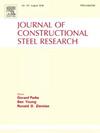Monotonic behaviour of stainless-clad bimetallic steel and their welded joints
IF 4
2区 工程技术
Q1 CONSTRUCTION & BUILDING TECHNOLOGY
引用次数: 0
Abstract
This paper describes a series of structural tests on standardized coupons of stainless-clad (SC) bimetallic steel plates and their welded joints under various actions. Despite the clad layers of the stainless steel are bonded at a metallurgic level onto the substrate plate of carbon steel, it is important to establish that debonding of the clad layer from the substrate plate, i.e. an integrity failure within the SC plates, will not take place prematurely. These structural tests include i) debonding tests along the interfaces of the stainless steel and the carbon steel of the SC plates under shear and tension actions; ii) tension tests on the SC plates; iii) both tensile and bending tests on the welded joints of the SC plates. It is shown that among all these tests on the SC plates and their welded joints, the interfaces of the SC plates are very strong and fully intact under various global and local actions. The SC plates are considered to be highly effective, and enhancement provided by the clad layers of the stainless steel to the substrate plates of carbon steel is totally reliable up to its fracture. Moreover, the welded joints of the SC plates are always stronger than their base plates under the effects of welding. Consequently, it is demonstrated that these SC plates are able to meet various stringent structural requirements in construction, and they are able to sustain large applied loads even up to large deformations.

不锈钢包层双金属钢及其焊接接头的单调行为
本文对不锈钢复合双金属钢板及其焊接接头在各种作用下的标准化接头进行了一系列结构试验。尽管不锈钢的包覆层在冶金水平上与碳钢的基材板粘合在一起,但重要的是要确定包覆层与基材板的脱粘,即SC板内的完整性失效,不会过早发生。这些结构试验包括i) SC板在剪切和拉伸作用下沿不锈钢和碳钢界面的脱粘试验;ii) SC板的拉力试验;iii) SC板焊接接头的拉伸和弯曲试验。结果表明,在各种整体和局部作用下,SC板及其焊接接头的界面非常坚固,且完好无损。SC板被认为是非常有效的,不锈钢复层对碳钢基板的增强是完全可靠的,直到其断裂。此外,在焊接的作用下,SC板的焊接接头总是比其底板强。因此,证明了这些SC板能够满足施工中各种严格的结构要求,并且能够承受大的施加载荷,甚至可以承受大的变形。
本文章由计算机程序翻译,如有差异,请以英文原文为准。
求助全文
约1分钟内获得全文
求助全文
来源期刊

Journal of Constructional Steel Research
工程技术-工程:土木
CiteScore
7.90
自引率
19.50%
发文量
550
审稿时长
46 days
期刊介绍:
The Journal of Constructional Steel Research provides an international forum for the presentation and discussion of the latest developments in structural steel research and their applications. It is aimed not only at researchers but also at those likely to be most affected by research results, i.e. designers and fabricators. Original papers of a high standard dealing with all aspects of steel research including theoretical and experimental research on elements, assemblages, connection and material properties are considered for publication.
 求助内容:
求助内容: 应助结果提醒方式:
应助结果提醒方式:


